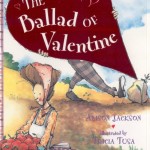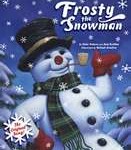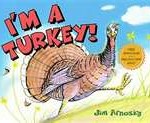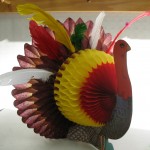The Piggy in the Puddle
 “See the piggy,
“See the piggy,
see the puddle,
see the muddy little puddle.
See the piggy in the middle
of the muddy little puddle.”
This classic tongue-twisting pig tale, The Piggy in the Puddle, by Charlotte Pomerantz and James Marshall is almost 40 years old, and it is still pure fun to read aloud. The muddy little piggy in the middle of the puddle is told by her family that she must come out of the “squishy-squashy”, “mooshy-squooshy”, “oofy-poofy” mud. Her reply? “Nope!” So what’s a pig to do but join her? Soon the whole family, “big and little”, are “in the very merry middle.”
After you’ve read this book through once just for fun, see if your listeners can keep a simple beat for you as you read it aloud again – just make sure the beat isn’t too fast or you’ll end up tongue-tied! You can use this book with preschoolers through third graders to talk about sounds. Little ones can focus on beginning sounds of P and M, older ones can sort words with short i or short u sounds, or look for “double letters”. For a super-simple craft (because that’s how I roll), I die-cut pigs for kids to glue to construction paper, and then, using just one fingertip (so we wouldn’t end up muddy like the pigs) we dabbed brown paint on our paper to make mud puddles and muddy piggies. Good, clean(ish) fun!
For more information, visit charlottepomerantz.com.
Read MoreThe Ballad of Valentine
 “Oh my darling, oh my darling, oh my darling Valentine,
“Oh my darling, oh my darling, oh my darling Valentine,
I have written forty letters, but you’ve never read a line.”
Alison Jackson and Tricia Tusa have me singing this Valentine’s Day. In their book, The Ballad of Valentine, a narrator tries most every way he can to let his true love know how he feels about her: he trains a homing pigeon and attaches a note with twine, taps a note in Morse code “asking you to please be mine”, rents out a mail car on the westward railroad line, but nothing works. Thank goodness his true love isn’t a gal who just waits around, for although his efforts fail, she’s been busy baking a cake and she asks him to be her Valentine.
After you croon this book along with your little darlings, have them take a look at all the “ine” words. We call our lists of words with the same endings “word families”, so make an “ine” word family with your little ones. You can go through the book and see which ones Alison Jackson used, and then brainstorm more to add to the list. Sitting in a circle, you can pass around a clementine to each student, or roll a ball of twine, and have kids come up with an “ine” word. Practicing rhymes with your Valentines – it’s divine!
For more information, visit alison-jackson.com.
Read MoreFrosty the Snowman!
 When I sing to my own ‘tweenage kids, they roll their eyes and beg me to stop. But when I sing to preschoolers and kindergartners, I get instant engagement. That’s why I love books that can be sung, like Frosty the Snowman written by Steve Nelson and Jack Rollins and illustrated by Richard Cowley. When I opened this book and started to sing the words to my kindergarten classes, immediately I had kids singing along (including one sweet girl who knew none of the words but still sang “laaa laaa la la laaa!” with vigor and obvious enjoyment.) Fidgeting stopped, and swaying in time to the music began. Eyes followed each page turn. And when I was done reading Frosty the Snowman, eager hands reached for it so they could sing-read it themselves.
When I sing to my own ‘tweenage kids, they roll their eyes and beg me to stop. But when I sing to preschoolers and kindergartners, I get instant engagement. That’s why I love books that can be sung, like Frosty the Snowman written by Steve Nelson and Jack Rollins and illustrated by Richard Cowley. When I opened this book and started to sing the words to my kindergarten classes, immediately I had kids singing along (including one sweet girl who knew none of the words but still sang “laaa laaa la la laaa!” with vigor and obvious enjoyment.) Fidgeting stopped, and swaying in time to the music began. Eyes followed each page turn. And when I was done reading Frosty the Snowman, eager hands reached for it so they could sing-read it themselves.
Books that can be sung are perfect to support early readers because they can easily memorize the words and then use that knowledge to match the words they see on the page with what they already know. Frosty the Snowman also has that great, catchy part at the end: “Thumpity-thump-thump, thumpity-thump-thump.” After we read the book, we practiced patting that rhythm on our knees. You can count it as “1-2-3, 1, 1, 1-2-3, 1,1”. For a listening activity that involves movement, you can make up easy patterns for your little ones to hear and copy: “1, 2, 1,2” or “A, B, A, B”. It can become a sequencing activity and a “reading patterns” lesson. I’ve had kids tap out rhythms we write on the board in words: “knees, head, knees, head” or you can assign letters, colors, etc. Kids can read the pattern, predict how it continues, and then tap out the rhythm with hands, pencils, or chopsticks (I asked my local Chinese restaurant to donate 30 pairs and they gave me a huge bagful! Thanks, Golden Buddha!)
Follow up the listening/sequencing activity with a drawing/writing activity. Give students a sheet of paper with this written at the top:
Frosty the Snowman was a jolly, happy soul
With a _________ and a ________ nose and two eyes made out of ________.
Little ones can draw a snowman and fill in the blanks. With so many fun ways to use this book, Frosty the Snowman is sure to warm your kids’ hearts.
I’m a Turkey!
 When I was little, I had a book with a 45 rpm record (yep, I’m that old) that I loved. It was “A Lot of Hot Water” read by Gordon from Sesame Street. Audio recordings of books have gone through a media transition or two, but it’s still a thrill to hear a good story read aloud by a talented reader. Jim Arnosky has a free downloadable MP3 version of his song “I’m a Turkey“, and my preschoolers this week gobbled it up. Arnosky’s folksy singing style is just right to get little listeners talkin’ turkey with him. The large art and short text in this book make it a fast, easy storytime choice. I’m going to share more books with cds or MP3 versions with my students. I’m sure they enjoy listening to another voice besides mine!
When I was little, I had a book with a 45 rpm record (yep, I’m that old) that I loved. It was “A Lot of Hot Water” read by Gordon from Sesame Street. Audio recordings of books have gone through a media transition or two, but it’s still a thrill to hear a good story read aloud by a talented reader. Jim Arnosky has a free downloadable MP3 version of his song “I’m a Turkey“, and my preschoolers this week gobbled it up. Arnosky’s folksy singing style is just right to get little listeners talkin’ turkey with him. The large art and short text in this book make it a fast, easy storytime choice. I’m going to share more books with cds or MP3 versions with my students. I’m sure they enjoy listening to another voice besides mine!
After sharing I’m a Turkey, we stretched by doing the Turkey Jerky. It’s like the Hokey Pokey, except you put your right wing in, your left wing, your tail feathers , etc. After announcing “that’s what it’s all about!”, we gobbled twice instead of clapping.
 Next, I gave each student a feather from the craft store. I showed them this turkey decoration (the kind that folds flat to store but unfurls into a kind of fan for show) and we said this rhyme:
Next, I gave each student a feather from the craft store. I showed them this turkey decoration (the kind that folds flat to store but unfurls into a kind of fan for show) and we said this rhyme:
There was a little turkey who had lost his tail.
When he saw it was gone, he began to wail.
“Oh woe is me! Please tell me whether
You have found my red tail feather!”
Whoever had a red feather could stick the feather in one of the holes on the turkey. We repeated the rhyme and changed it until all the colors of the feathers were used. It took me less prep time to use the turkey decoration and feathers we already had than to make the bulletin board out of construction paper like I’d originally planned, and the students loved sticking in the real feathers. Having two easy, inexpensive activities to go with a book sung by a fun artist made me very thankful indeed!
For more information, visit jimarnosky.com.
Read More






